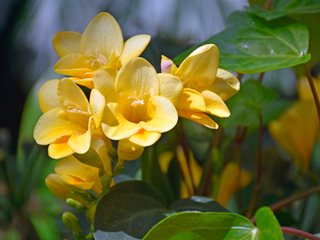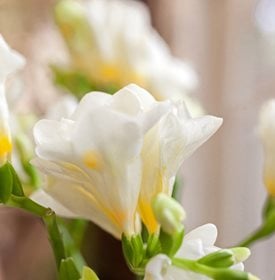Freesia Flowers - How to Grow Freesia Plants Indoors or Out
Bright, colorful, and delightfully fragrant, these exotic bloomers are surprisingly easy to growFreesias have long been a mainstay in florist shops because of their intoxicating scent, long vase life, and enticing array of jewel-toned colors. But why not grow them in your own home and enjoy their sweet perfume and delicate floral beauty for months on end? These welcome winter bloomers are easy to force indoors as inexpensive, longer-lasting alternatives to cut flowers. In addition to being gorgeous houseplants, freesias will also thrive outdoors in garden beds or containers with properly timed planting.
On this page: Basics | Forcing Indoors | Planting in the Garden | Cut Flowers | Freesia Pictures | Buying Tips
BASICS
Botanical name:
Freesia spp.
Plant type & origin:
Frost-tender perennial that grows from corms. Native to South Africa.
Zones:
9 to 10
When to plant:
For growing indoors, plant any time from mid-August to late October for flowers from January through April. In the garden, plant outdoors in spring for summer flowers or in fall (in frost-free climates only) for spring blooms. In colder growing zones, start indoors in late winter and then move them outside in spring, displaying them right alongside your hyacinths, tulips, and daffodils.
Flowering period:
Freesias normally produce flowers 10 to 12 weeks after planting. Once they begin to bloom, they'll stay in flower for six weeks or longer. As with orchids, the blooms open sequentially along the stem, rewarding you with new flowers even as older flowers fade.
Height:
12 to 24 inches
Flower colors & characteristics:
Freesias’ trumpet-shaped flowers open on just one side of their slender, arching stems, with the blooms always facing upward for better viewing. Each stem may bear as many as 12 flowers. Numerous hybrids are available in a rainbow of colors including white, yellow, orange, scarlet, pink, royal blue, lavender, and various bicolors. You can also choose from single or fuller, double-petaled blooms
HOW TO FORCE INDOORS
Planting:
Fill a tall pot (one with adequate drainage holes) half-full with a well-draining potting mix. Plant the corms 1 to 2 inches deep with their sprouting tips pointing upward. You can usually fit six to eight corms in a 6-inch pot. Add more soil to barely cover the corms, and gently tap it down. Learn more about forcing bulbs indoors.
Soil:
Average potting soil works fine, but the addition of vermiculite or sand will help to improve drainage and prevent soggy soil.
Lighting/temperature:
When the top growth is 1 to 2 inches high, move your pot to a sunny location with cool temperatures (below 70° F). Freesias grow best in a chilly atmosphere. Conditions that are too warm can inhibit blooming.
Watering:
Water well after planting, and then provide just enough water to maintain even moisture.
Fertilizer:
When the first buds begin to appear, start fertilizing every two weeks with a water-soluble plant food.
Staking:
One of the drawbacks is the long, slender foliage, which tends to flop over unless supported. To keep it upright, insert a tall bamboo stick or wire ring support next to each corm when you plant it. When the foliage becomes untidy, loosely tie it to the support with string or floral wire. You can tie the flowering stems, too, or let them dangle gracefully.
Aftercare:
Most freesia plants are discarded after flowering because the corms are so inexpensive, often costing less than 50 cents each. But if you want to save the corms and encourage them to rebloom, let the foliage die back after the flowers have faded and reduce watering. After about six to eight weeks, remove the corms from their pot, allow them to dry thoroughly, and then store them in a paper bag in a cool location (around 40° to 50° F) until you’re ready to replant them in late summer or fall.
PLANTING IN THE GARDEN
Exposure:
Full sun
Soil:
Well-drained, fertile soil enriched with plenty of organic matter.
Planting depth and spacing:
Plant about 1 to 2 inches deep with the pointed end facing up. For an eye-catching floral display, plant in groups of at least six corms and space them 2 to 3 inches apart. As when planting corms in pots, add stakes to support the flower-laden stems.
Watering:
Keep the soil evenly moist during the growing season, especially during dry spells. Freesia corms can rot in wet, saturated soil so allow the soil to dry a bit between watering.
Winter care:
In colder climates, dig up the corms from garden beds in the fall, before the first frost, and store them in a cool, dry place where they can remain dormant for a minimum of four months before being replanted again in spring; or consider planting your freesias in containers that you can bring indoors for winter storage. Although you can store corms in their pots, they must be repotted before they are brought into bloom again.
USING AS CUT FLOWERS
Freesias are a must for the cutting garden so you can enjoy their heady fragrance in spring and summer bouquets. They can last as long as three weeks in a vase if cut in the closed-bud stage, when the first flowers are just beginning to show color. Cutting the flowers will not hurt your plants, but if you want the corms to replenish their energy for the next growing season, be sure to leave the foliage intact.
To extend the life of your cut freesias, trim
Learn about other great flowers to grow for garden bouquets.
FREESIA PICTURES
BUYING TIPS
A few things to keep in mind when shopping for freesias:
- Freesia corms are often sold in packages of single colors or in coordinated mixes. If you intend to plant them right away, look for corms that have been preconditioned for forcing, which means they have gone through the dormancy period they need in order to grow when you purchase them.
- Do a size comparison. Larger corms contain more stored energy and will often produce more stems and flowers.
- For the best scent, choose freesias that have pure white or yellow blooms because they are often the most fragrant. Darker shades, such as reds and purples, have the lightest scent.
RELATED:
Top 20 Spring-Blooming Bulbs
Warm-Climate Flower Bulbs: Choices & Design Tips
Forcing Indoor Bulbs
Planting and Storing Flower Bulbs
20 Fragrant Flowering Plants











